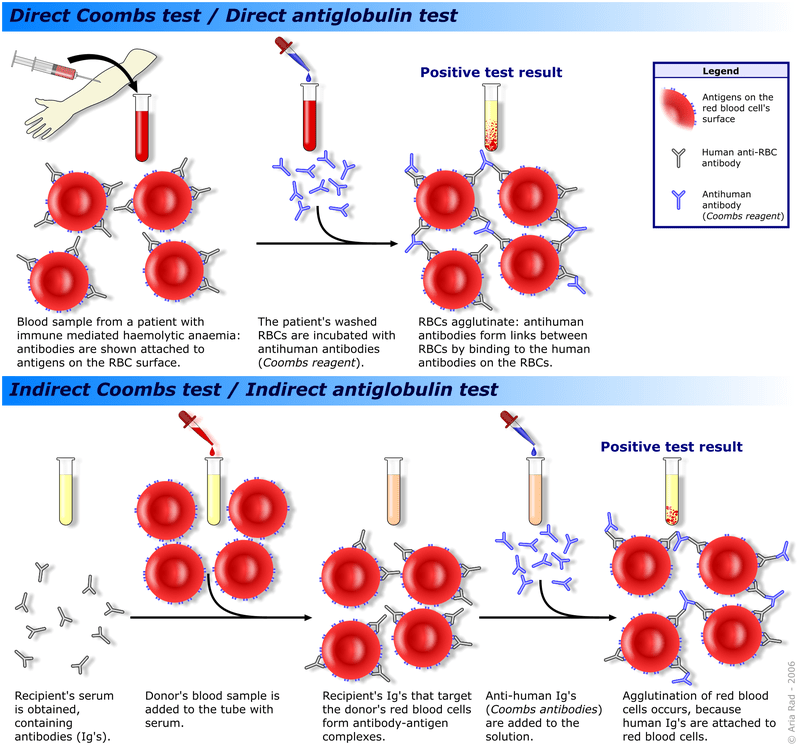Difference Between Direct and Indirect Coombs Test
Key Difference – Direct vs Indirect Coombs Test
Coombs test is a type of blood test used to diagnose anemia conditions. It detects the presence of some antibodies produced by the immune system. These antibodies are able to destroy red blood cells in the blood, causing low red blood cell counts. Hence, the presence of antibodies indicates the presence of red blood cell attackers, which can lead to anemia conditions. Two types of Coombs test are available to detect these antibodies. They are direct and indirect Coombs test. The direct Coombs test is done on a sample of red blood cells to detect antibodies that are already attached to red blood cells. The indirect Coombs test is done to the liquid part of the blood (serum) to detect antibodies that are present in the bloodstream and could bind to certain red blood cells which can cause problems during blood transfusions. This is the key difference between direct and indirect coombs tests.
CONTENTS
1. Overview and Key Difference
2. What is Direct Coombs Test
3. What is Indirect Coombs Test
4. Side by Side Comparison – Direct vs Indirect Coombs Test
5. Summary
What is Direct Coombs Test?
Certain antibodies are capable of destroying a person’s red blood cells, leading to low red blood cell levels in the blood. Coombs test is an immunological test that can detect these antiglobulins, mainly IgG alloantibodies, IgG autoantibodies or complement components present in the blood. Coombs test follows two main methods, namely direct and indirect coombs tests. Direct coombs test is performed to detect the antiglobulins attached to the surface of the red blood cells. It is a simple test which gives quick results. A blood sample is taken from the patient and treated with coombs serum (antihuman globulins). Antihuman globulins facilitate the linking between red blood cells and cause agglutination of the cells. Agglutination of the blood indicates positive results for the coombs test. It reveals the presence of antibodies attached to red blood cells surface antigens.
What is Indirect Coombs Test?
Indirect Coombs test detects the presence of antiglobulin antibodies in the blood plasma (serum) which are responsible for red blood cell agglutination and lysis. This test can reveal the presence of antibodies which are unbound to the surface of the red blood cells. It is important to detect these antibodies present in the serum before a blood transfusion to prevent the destruction of transfused blood and in preparations of blood for transfusion.
Indirect Coombs test is performed as follows prior to blood transfusion.
If the recipient serum contains antibodies, they bind to the antigens present on the surface of the red blood cells of the donor and forms antigen-antibody complexes. If agglutination occurs when the coombs antibodies are added to the sample, the indirect Coombs test is positive. It reveals the presence of antibodies which are responsible for the auto hemolysis of red blood cells.

Figure 01: Direct and Indirect Coombs Tests
What is the difference between Direct and Indirect Coombs Test?
Direct vs Indirect Coombs Test | |
| Direct coombs test detects the presence of the antibodies attached to the surface of the red blood cells. | Indirect coombs test detects the antibodies present in the serum which are not bound to the red blood cells. |
| Frequency of Use | |
| This type is more common. | Indirect Coombs test are performed rarely. |
| Importance | |
| Direct coombs test is important to diagnose autoimmune hemolytic anemia. | Indirect coombs test is important for prenatal testing for pregnant women prior to blood transfusion. |
| Detection in in vivo or in vitro | |
| Direct coombs test can detect in vivo antigen-antibody interactions. | Indirect coombs test can detect in vitro antigen-antibody interactions |
Summary – Direct vs Indirect Coombs Test
Coombs test is an immunological tool which identifies the autoimmune hemolysis of red blood cells due to the presence of antiglobulins in the blood. Coombs test is also known as agglutination test since the final observation is the agglutination of the red blood cells. There are two main types of the coombs test: direct and indirect. Direct coombs test is preformed to detect antiglobulins attached to red blood cell surfaces and their interactions in vivo. Indirect coombs test is performed to detect the presence of antiglobulins in the serum in unbound state and to detect their interactions in vitro with Coombs’ antihuman globulins. This is the main difference between direct and indirect Coombs test.
References:
1. Zarandona, J. Manuel, and Mark H. Yazer. “The role of the Coombs test in evaluating hemolysis in adults.” CMAJ : Canadian Medical Association Journal. Canadian Medical Association, 31 Jan. 2006. Web. 29 Mar. 2017
2. “Direct Antiglobulin Testing.” Overview, Clinical Indications/Applications, Test Performance. N.p., 08 Feb. 2017. Web. 29 Mar. 2017
3. Angelis, V. De, C. Biasinutto, P. Pradella, E. Vaccher, M. Spina, and U. Tirelli. “Clinical significance of positive direct antiglobulin test in patients with HIV infectionDirekter Antiglobulintest bei HIV-infizierten Patienten.” SpringerLink. Springer-Verlag, n.d. Web. 29 Mar. 2017.
Image Courtesy:
1. “Coombs test schematic” By A. Rad~commonswiki assumed (based on copyright claims). – Own work assumed (based on copyright claims) (CC BY-SA 3.0) via Commons Wikimedia
ncG1vNJzZmivp6x7pbXFn5yrnZ6YsqOx07CcnqZemLyue8OinZ%2Bdopq7pLGMm5ytr5Wau26wyKucnKxdlruledWsZKKmlJ6%2Fpq%2FTZpqop52XwG7AxKyraA%3D%3D